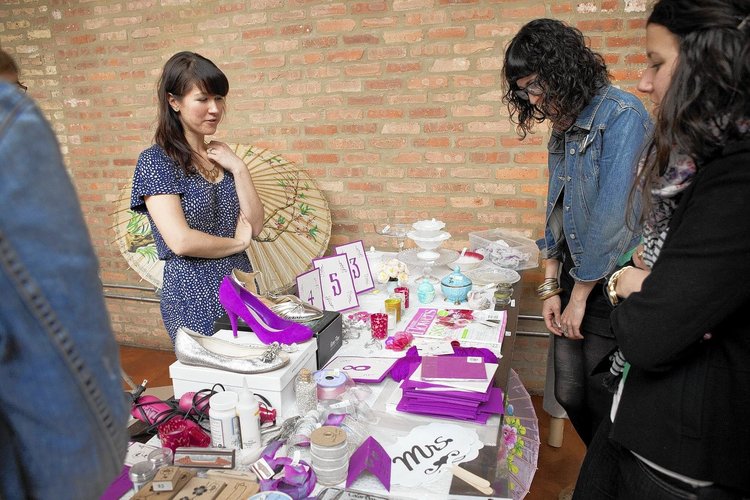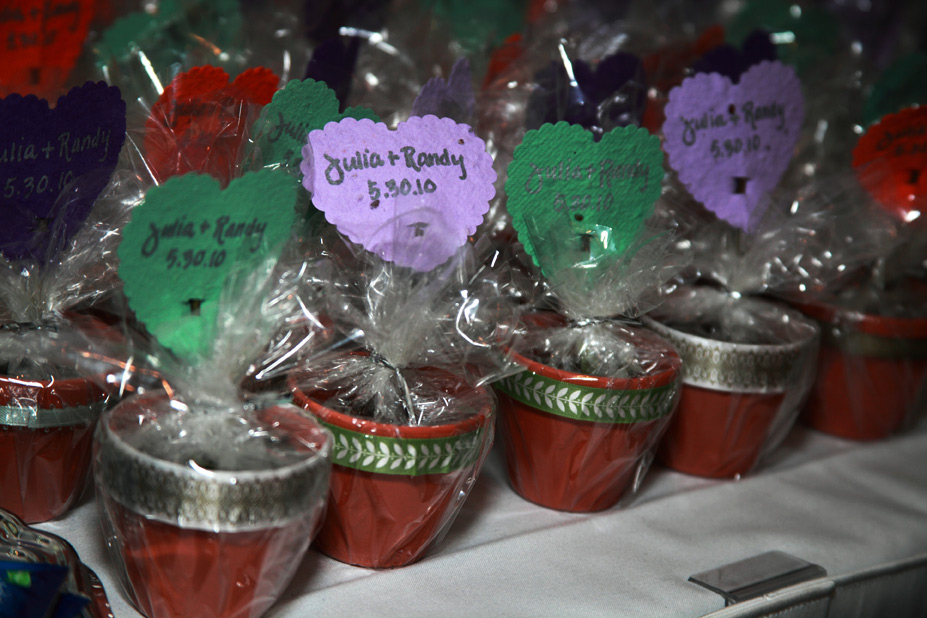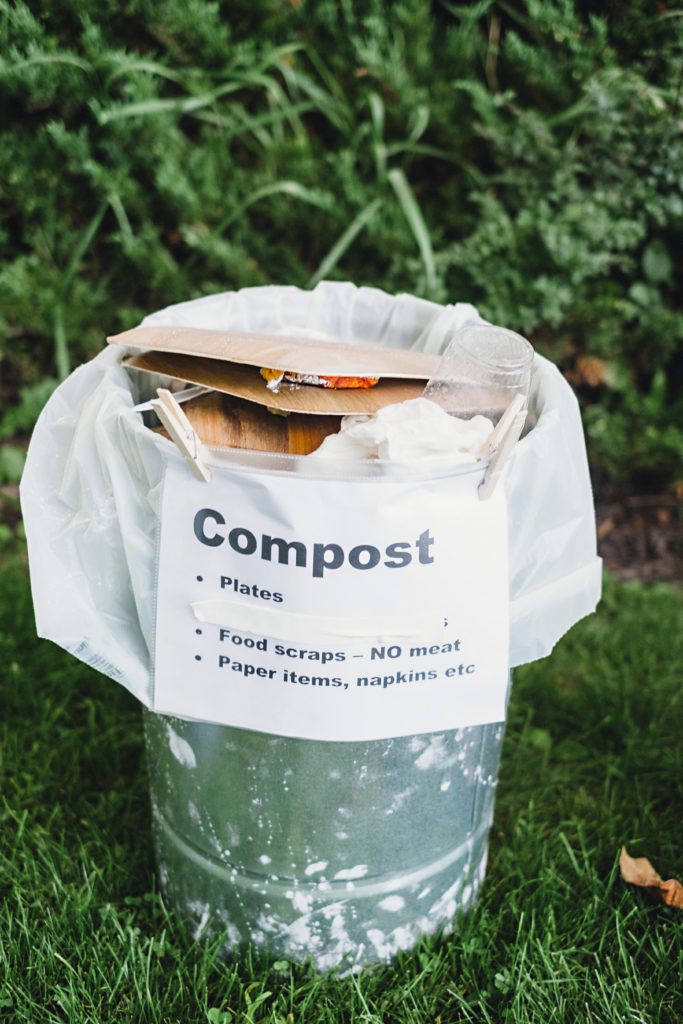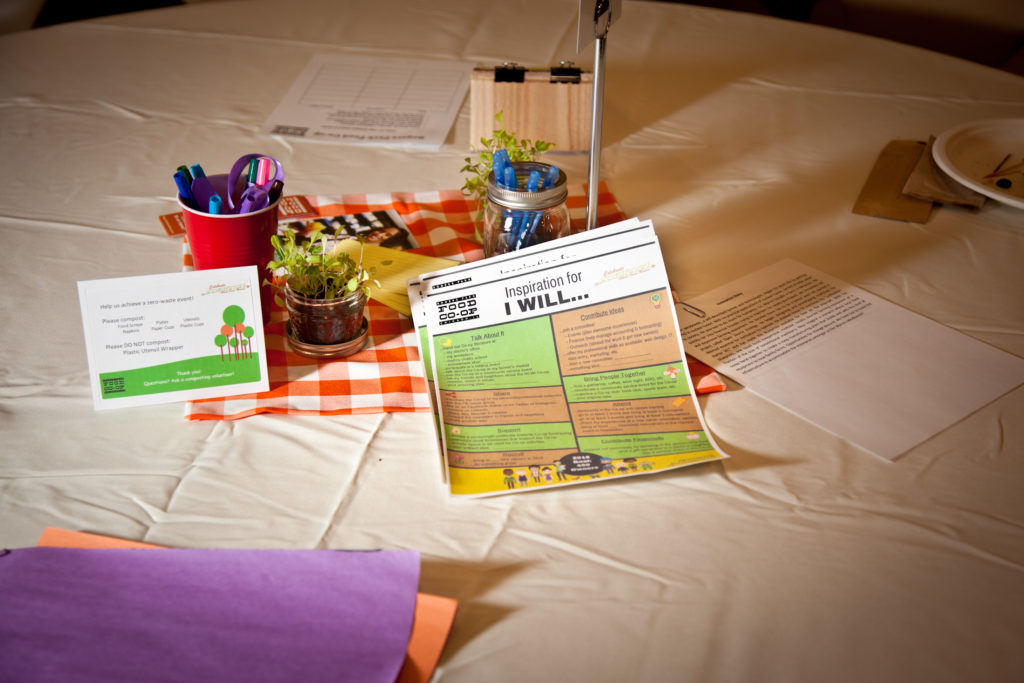Mar 4, 2019 | Eco-Friendly Events

This could be you at the Great Wedding Recyclery!
The party is over, the wedding is a happy memory, and now you have 300 votive candles in your possession. What’s an eco-minded person to do? Rent a table at the Green Wedding Alliance’s The Great Wedding Recyclery, of course, and sell them to someone else who needs them for their wedding!
Or maybe you are still planning your wedding and looking for gently used decor on a budget. Where should you go? Loft on Lake, 1366 W. Lake St. on Sunday, April 7, 2019. First Pick access from 11:00-11:30am is $15 (available only at the door); and general admission from 11:30-1:00pm is $5. You can buy general admission tickets here.
This is at least the fifth time the GWA has sponsored this fabulous and sustainable event, and it is always a big hit with everyone. I have personally seen some amazing bargains on beautiful, whimsical, and useful items. It’s also a fun way to spend a Sunday morning. There is usually music and a party atmosphere; sometimes there are small bites.
Best of all, though, it’s an easy and fun way to keep wedding items out of the landfill. The wedding business can be very wasteful, and this is one way to make it less so. Check out the Recyclery, and green your corner of the world just a little bit.
Feb 4, 2019 | Eco-Friendly Events, wedding planning

Popcorn wedding favors? Yes, please! There were none of these left at the end of the night.
Here is one fairly easy way to make your wedding (or other party) more eco-friendly: Think about your wedding favors.
The greenest thing you could possibly do with favors would be to have no favors at all. After all, if there’s no favor, then there’s no waste. But that is not the way everyone wants to have things. So, if you are going to give favors, here are three things to consider: the type of favor, the place of manufacture, and the quantity to buy.
Probably the least sustainable type of wedding favor is the small object imprinted with the couple’s name and wedding date, especially if it is something plastic. Obviously, there are exceptions, but these types of things are the things that most people throw out after a while. It’s a lot of waste. A small object that is recyclable, compostable, or growable is a step in a cleaner direction. Something consumable or really useful might be even better. Food and beverages probably won’t go to waste–although you might want to give some thought to the type of containers they are in. Plastic cupcake boxes or nylon almond bags are likely to generate waste. Glass bottles are more likely to be recycled. Donations in lieu of favors sidestep the issues of waste entirely–and you could give money to an organization that works on issues of sustainability, if that is your wish. There is a whole range of possibilities here (and others I’m sure I’ve missed) that allow you to make your celebration more eco-friendly.
If you do decide to give your guests a small token, consider where and how it is made. Things that are cheaply made overseas have to be shipped here, which is a lot less sustainable than things made locally. You might also want to consider the ethical issues of cheaply made goods: They are generally made by people (sometimes children or prisoners) who are paid less than a fair wage. While it often costs more to buy from a local producer, at least you can verify the conditions of manufacture to be sure the creators are being paid fairly.
The other thing to consider is how many things to buy for your guests. In my experience, there are almost always favors left over at the end of the night (unless it’s a very popular food item). Often, guests will take one favor per household, rather than one per person. Some people just don’t want them. When you are deciding what kind of favor to get, take this fact into account. If you buy one per guest, you may well have to figure out what to do with the leftovers. You might want to purchase fewer than the number of guests so you don’t have to solve that puzzle. Or be sure to buy something that is easy to donate or resell.
While there are much bigger things you can do to green your wedding, this one is fairly easy and can be inexpensive. It’s something within the reach of many more people than, say, serving only organic local food. So, if you want to have a more sustainable celebration, you can start here. It’s always better to do something than to do nothing.
Jun 25, 2018 | Eco-Friendly Events

It’s the little things that count: This couple was able to give sustainable favors to their guests. Photo courtesy of christytylerphotography.com
I run into a misconception sometimes: Green weddings are an East (or West) Coast fad for fashionable rich people who can afford to be sustainable. Nothing could be further from the truth! Far from being a fad or a lifestyle choice for the well-to-do, eco-friendly weddings and celebrations are an easy choice for everyone.
I think when people think of being environmentally conscious, they automatically assume the need for organic food and flowers–and we know that organic is going to be more expensive than conventional. On the other hand, I would say that while organics are one possibility at your celebration, it is probably more important to make sure that there is a minimum of food waste, and that might actually save you money.
The thing about sustainability is that it often means doing less, rather than spending more. Maybe you will decide to skip buying favors for your guests, for example. That means less shipping and less overall waste, and it is less expensive. Perhaps you will opt for a venue that needs no decoration so you don’t have to put money into decor that just gets thrown out. Or, if you have decor left over, you can get it into the hands of someone who will re-use it. That might make you money, or, at least, will cost you nothing but time. And it is very eco-friendly!
The important thing to remember is that perfectly green solutions don’t exist. No one is insisting that if you have an environmentally friendly wedding that it has to be perfectly so. Frankly, I don’t think that any kind of standard of perfection ought to be applied to weddings, including how sustainable they are. If you want an eco-friendly wedding, do what you can with the time and money you have available. Every little bit helps.
And if you are expecting to hire a planner or day-of coordinator, you might as well hire one who can help you green your wedding. That doesn’t cost any more than any other kind of planner!
Jun 11, 2018 | Eco-Friendly Events

It is all about the compost bucket! Photo by Ryan Timm Photography.
A number of years ago, I wrote a post about compostable disposable dishes. At the time, it was the most accurate, up-to-date information I could find on the subject. But the world has evolved since then, and there is more to know now. So, here are some updates with what is new on the topic:
First, just what is a compostable disposable? Well, plastic (like, for plates, cups, flatware, etc.) can be made from petroleum. That kind is definitely not compostable and you have to throw it out. It is anything but eco-friendly.
But plastic can also be made from corn or sugar cane or various other plant-based sources. Dishes and so on made from that kind of plastic are marketed as being compostable. Compostable dishes can also be made from paper or from wood, such as bamboo. In theory, all of these dishes will break down into rich soil, given the right combination of heat, moisture, other nutrients, and microbial activity. Those dishes are more sustainable, as they don’t use petroleum as a base and they don’t have to end up in a landfill. In a perfect world, they end up on someone’s garden bed making the roses bloom.
So far, so good. But is it really that easy? Well, the first thing to know is that most of the compostable products that are available will not break down in your home compost pile. I have had good experiences with the kind of paper cups and bags that have a thin PLA (plant-based plastic) paper lining. It can still take a year or more for the plastic to degrade, but it does happen eventually. That is not the case with any of the heavier plastics, which require a very hot commercial composting facility.
The other thing to consider is the sourcing of the raw materials. It’s great that such a common (and local to the Midwest) crop such as corn can be used to make party dishes. I always wonder, though, if that is the best use of farmland. The jury is still out on this, but if using corn for plastic ends up driving up food prices, then perhaps it is an unsustainable practice in other ways than environmental. (In 2006, Smithsonian Magazine had a very good article that covered that issue, as well as many others implicated in the subject. For more updated information, try a web search on “biodegradable plastic problem” and you’ll turn up many more articles on the subject.)
What does all this mean for your eco-friendly celebration? One thing hasn’t changed: Probably the least wasteful, lowest impact kind of dishes are reusable ceramic dishes. If you don’t own them, you can rent them. (Or ask your planner for a list of facilities that include dishes in their rental cost!)
If you find that disposables are the best options, shop carefully. I find that restaurant supply stores have the best selection and prices. I like the Eco Products Store and Greenstaurant for most items. Read the descriptions thoroughly, though, and make sure the items are labeled as being compostable, as not everything on each site is. Also, don’t overlook the fact that standard-issue uncoated paper plates and paper napkins are all compostable.
Once used, you’ll want to make sure that all these compostable dishes (as well as food scraps) actually get composted and not thrown out. The easiest way to do that is to hire a composting service. My personal favorite is Collective Resource. They have drop-off service, as most composting companies do, but they will also send a staff member to your event to monitor the compost container and make sure everything is sorted properly. I recommend this highly if you want to be sure that only compostables get into the compost bucket, and that garbage or recycling goes elsewhere.
If you want to search out other composting services, a good (although incomplete) resource is Find A Composter, a national database of composting services.
Composting for your event has gotten a lot easier and more reliable in the last decade. We are definitely making progress in this area. I hope in another decade, we will see more big changes that improve the ways we can throw sustainable parties.
Mar 26, 2018 | Eco-Friendly Events, Other Events

Here’s what we had on the tables on Saturday night. Photo by Darren Day Photography.
One of the things I do with my skills is volunteer my time to the Rogers Park Food Co-op. I’m currently the chair of the Events Committee for this start-up business. In case you don’t know how food co-ops work, here’s a short summary:
A co-op is a community-owned business. The backing for it comes not from a corporation or from billionaire investors but from individual share sales to members of the community. As you can imagine, this is hard work. In order to make it work, it is necessary for hundreds or thousands of people to come together, raise money, and make it all happen. And it is all powered by volunteers.
Once a year, we have our Annual Owner Celebration, a gathering for everyone who has bought a share in the business. It is a time to make sure everyone knows what is going on and to energize everyone to work toward our goals. And my small committee plans everything.
It’s a big deal event: rental venue, catering, photography, decor, speakers, meeting activities, tons of stuff to be transported, dozens of volunteers, and so on. We were expecting 130 people to show up at 6:00 at the Levy Center in Evanston. Set-up started at 4:00.
But, at 2:30, my phone rang, a call from an Evanston Park District manager with some very bad news. Levy Center was closed for the rest of the day because of a MAJOR sewer back-up that affected the entire building. The bathrooms were unusable; the kitchen was unusable; the entire building (reportedly) smelled of sewage. Plumbers were on the job but they would not be finished any time soon–and then the place had to be cleaned up.
It was the exact script of the event planner’s nightmare. That’s how it always goes in bad dreams. Only, in the actual nightmare, no one will help you, there is no equipment, and you flail about trying to salvage an impossible situation. Reality was actually much better.
The saving grace was that they were able to offer the use of another park district facility at the other end of town. The room is not as nice; the sound system is not great (and one of the reasons I wanted to use the Levy Center was their excellent sound system); and there’s no real kitchen. But at least it was a room that could accommodate our needs.
City staff hauled the tables from Levy to Chandler, brought in the sound system, and were generally very helpful. We just had the enormous task of making sure all 130 people knew about the change in plans!
Five or six of us from the committee and the board got on a conference call and worked out an emergency communications and transportation plan in about half an hour. I was texting and emailing volunteers all during that time, too. I notified catering and photographer (almost forgot the photographer!), scrambled my stuff together, and got there in time to re-do the ground plan on the fly and start wrangling volunteers.
And then, after all that, we had our event. No, no, I’m not tired at all. Why do you ask?
Dec 4, 2017 | Eco-Friendly Events

Photo by Ryan Timm Photography.
Okay, so technically this is not just a resource for weddings, events, and parties. It’s for everyone, all the time. And it’s not glamorous. I’m talking about the Solid Waste Agency of Northern Cook County (or SWANNC). Even for people who don’t live in Northern Cook County, this website has a huge amount of information that is useful.
There is a directory of resources for reusing and recycling that covers everything from Appliances and Automobiles through Fire extinguishers, Make-up containers, and Shoes to Wood recycling and Yard waste. Many of the resources are local, but many can be found regionally or nationally. My favorite discovery so far is places you can take polystyrene (Styrofoam) to be downcycled into other materials.
If you look under business resources, you will also find a Green Meeting Guide and a Zero Waste Event Guide. They are designed for use by businesses and mostly for corporate events, but there are some good tips that would also be useful for social events. Check them out if you’re planning a party and want to go green.
If you have questions about recycling, about donating goods, about composting–about pretty much anything that has to do with disposing of things–check out SWANNC and make them part of your next party.







Recent Comments